Introduction
The Green Movement
The concept of going green is based on the process of altering approaches towards the consumption and utilization of resources to ensure a more environmentally friendly method of using and consuming resources (Boss, 2010). The basis behind this is the assumption that since the Earth is a closed off ecosystem with a finite amount of resources if nothing is done to conserve and ensure these resources stay replenishable in the long run there may come a time when the Earth will no longer be able to support human civilization (Boss, 2010).
Such an assumption is not without merit, as the human population continues to expand so too does the demand for resources increase. Unfortunately, resources that command the highest demand (wood, freshwater, and food) are only replenishable to a certain extent while others have a set amount (oil, gas, and certain chemicals) and cannot be replenished at all. Advocates of environmental conservation such as former U.S. vice president Al Gore continue to reiterate the need to change the current rate and method of consumption to better utilize resources to ensure that they will continue to remain there for future generations (Reynoso & Heusinger, 2010).
It must be noted though that the concept of going green is not a recent trend rather it has been going since the early 1970s through the creation of various recycling programs and centers (Griskevicius et al., 2010). Despite this, it has only been within the past decade that the concept of environmental conservation has entered into popular culture. Advocates such as Al Gore, Nichol Richie, Lance Bass, and various other pop culture icons were among the primary reasons why environmental conservation became popularized with younger generations today.
While going green through resource conservation is financially beneficial for most companies many attempts the change over to create an effective means of product positioning with the general public (Boss, 2010). Various studies have shown that due to the growing trend in environmental conservation many consumers would be willing to spend money on products that indicate that they were created through environmentally beneficial practices rather than products that do not have such a distinction (Beil, 2009).
This has given rise to the concept of corporate “green washing” where corporations indicate that their products were created through environmentally conservative methods but follow ordinary resource wasting procedures (Beil, 2009). Even with such disreputable practices currently being done enough industries do see the benefits that going green has for both their operational capacity and their ability to appeal to consumers and as a result, many choose to change their operational models to account for added environmentally beneficial practices (Cater and Lowman, 1994). It must be questioned though whether going green contributes to consumer patronage of a particular hotel chain or are customers influenced more by other factors about consumer behavior?
Literature Review
State of the hotel industry in Singapore
The 2008 financial crisis deeply affected various hotel chains around the world due to the sudden decline in consumer spending and international travel which was the primary source of revenue for various hotels since international guests made up the bulk of their clients. An examination of Singapore’s hotel industry at the time reveals that while the Singaporean economy suffered a significant financial blow due to its orientation as an exported oriented country its hotel industry did not suffer as significant a loss as compared to its other counterparts around the world.
It must be noted that the 2008/09 financial crisis primarily affected the U.S. and European markets due to the U.S. housing crisis and the subsequent sub-prime investment fallout however markets in South East Asia, primarily within the A.S.E.A.N (Association of South East Asian Nations) were not as deeply affected due to tight fiscal and monetary policies adopted by their central banks which did not invest heavily into U.S. sub-prime backed securities.
As it turns out the 2008/09 recession did not have as large an impact on arriving visitors into Singapore because Americans and Europeans only made up 18% of the visitor arrivals coming into the country. Visitors from ASEAN member countries make up almost half of Singapore’s visitor source markets as well as various South and southeast Asian nations.
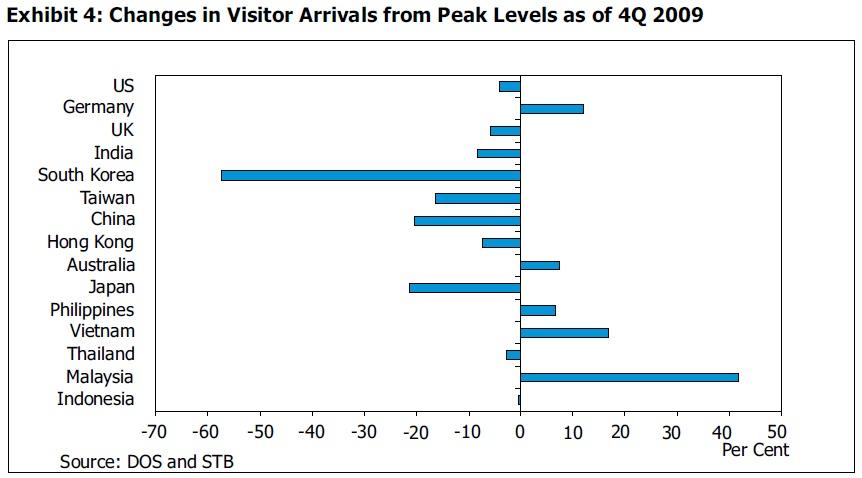
As can be seen in the graph there was a definite drop in the number of visitors from countries deeply tied into the state of the U.S. economy. Countries such as China, Taiwan, South Korea, and India are locations for various outsourced U.S. production facilities; a sudden decline in U.S. consumer spending would have a definite backlash on their economies as well since the U.S. is their biggest customer.
On the other hand, there is a significant increase in the number of visitors from various ASEAN countries which shows how the financial crisis did not deeply affect the various economies in the region. While this graph does not represent the entirety of Singapore’s visitor base that their hotel industry relies upon, it is an accurate enough representation of the type of visitors that enter the country on a daily basis.
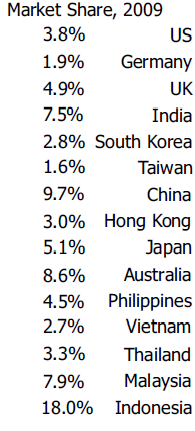
Research into the records of the Singapore department of statistics has resulted in the following graph on the 2009 market share of visitors going into the country. As can be seen, visitors from the U.S. and U.K. make up only 8.7% of the total amount of visitors going into the country with the lion’s share of visitors coming mostly from ASEAN countries, China, Hong Kong, India, and Australia. This might be due to the fact that Singapore acts as a financial center within the Asian region and deals primarily with Asian business interests.
This will prove to be an important factor to consider since the current environmental conservation movement has different impacts depending on the country in question. For example, the green movement is more prevalent in regions such as the U.S. and Europe as compared to countries in Asia such as India and China. While there is a benefit to going green the fact remains that guests from countries where the concept is fairly new and underused might result in survey results for this study showing a possibly negative outlook towards hotels going green due to the origins of the various consumers.
The situation of Hotels in Singapore
Every hotel has a different guest demographic that they are targeting, various hotel chains cater to different kinds of guest demographics, with some catering to guests seeking affordability while others cater to guests seeking luxury. The main difference lies in what the hotel in question is actually capable of doing, in terms of available resources, operational capacity, and type of services available. Hotel chains such as the Marriott, Hilton, and Shangri-la obviously have higher operational capacities and types of services available as such they cater to a higher class of consumers.
Other smaller hotel chains do not have the same level of operational capacity and types of service available as such they usually cater to consumer demographics that desire affordability and convenience over services and luxury. Such distinctions are important to take note of since how hotels attract customers is directly related to what their level of operations and services are capable of doing. In the case of Singapore, due to its relatively small total land area of 710.2 km2 and its highly developed market-based economy, the city district is more compact as compared to other countries which resulted in various hotel chains being located relatively close to one another.
Due to its distinction as a leading financial center, logistics hub, and port various major hotel chains such as Ascott International, Four Seasons, Hilton and Hyatt International have all set up various hotels within or near the central business district. This presents a rather unique competitive setup due to the fact that each hotel chain can be stated as offering roughly the same level of services, having the same level of operational capacity, and also having the same level of international distinction.
While such a setup is advantageous for consumers it is quite the opposite for the hotel chains present since attempts at price reductions, special offers or extra services can also be done by competitors with the same level of operational capacity and financial resources (Briassoulis and Straaten, 2000). It would be another matter if it was a major international hotel chain competing against smaller locally based hotels but in this situation, it is a case of international hotel chains competing against each other within a small confined location.
What must be understood is that, as a business, hotels try to achieve a certain level of profit in order to stay operational, as such in a situation where competition is high hotel chains concentrated within a certain area must find a way to distinguish themselves from their competition in a manner that is both profitable and results in a greater degree of guest patronage (Briassoulis and Straaten, 2000).
When examining the hotel industry in Singapore another factor that must be taken into consideration is the lasting effects the recent financial crisis will have on how hotels will continue to operate within the country. Even though the number of visitors coming into Singapore was not as heavily affected as compared to other regions the fact remains that there was a significant decrease in the number of people that visited the country which severely reduced the amount of income garnered by hotels from 2008 to 2009. An examination of the business expectations survey from the Singapore Department of Statistics reveals that during the height of the financial crisis the hotel industry was expected to sustain losses of up to -100% due to the lack of sustained international visitors into the country.
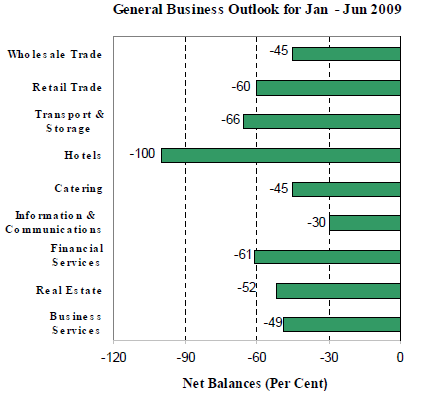
While this view may conflict with earlier statements indicating that the number of visitors coming into Singapore was not as heavily affected compared to other countries, this discrepancy can be explained by examining the earlier graph on the changes in the number of visitors coming into the country. As can be seen visitors from China, South Korea Taiwan, Japan, the U.S., U.K., India, and Hong Kong all displayed negative growth rates while visitors from Malaysia, Vietnam, the Philippines, Germany, and Australia all experienced positive growth.
What must be taken into consideration is the fact that many hotels within Singapore position themselves to target particular consumer groups; this is reflected in the type of services offered, operational capacities, type of guest relations, etc. Among the counties listed are China, Taiwan, Hong Kong, and South Korean, all of whom possess the type of clientele the various hotels in Singapore target (i.e. business men and rich tourists).
While there is nothing wrong with the type of service positioning that various hotels in the country are using the fact remains that the financial crisis has revealed an inherent weakness in this type of consumer positioning in that should another financial recession occur, hotels within Singapore will inevitably bear the brunt of this sudden lack of clientele. It must be noted that periods of growth and recession are actually cyclical and that while there may currently be a period of growth occurring there will inevitably be another recession on the way due to the nature of the financial system. Another factor that must be taken into consideration is the fact that the methods of operation of various hotel chains are considered wasteful and actually contribute to operational costs.
While this varies from hotel to hotel wasteful costs such as excessive water and electricity use as well as continuously replacing soap, shampoo, and sheets despite no inherent need actually drives up the cost of operations. Facility maintenance is actually one of the highest operational costs in the balance sheets of most hotels due to an apparent need to please guests which actually facilitates and even encourages wasteful practices that drive up the cost of operations.
Based on this wastefulness and the inevitability of a future recession affecting the number of visitors into Singapore, there is a definite need for various hotel chains within the country to shift to a more sustainable means of staying in business that will help reduce the cost of operations while at the saying time creating an effective means of product positioning that will help them a achieve a more diverse consumer base.
Wastefulness in the Hospitality Industry
Despite differences in their business culture, prices, and methods of operation all of the major international hotel chains within Singapore possess one thing in common and that is the ostentatious use of resources which results in wasteful spending. The reason behind this is simple, hotels want to attract guests through the feeling of luxury they perceive when they use the hotel’s facilities. This apparent luxury takes the form of resource wastefulness such as the overindulgent use of lighting, water, electricity as well as different types of food being shipped in through various international sources as well with items not meeting specific quality standards being thrown out.
While there is nothing wrong with maintaining high-quality standards at specific establishments there is a problem when such high standards promote an operational culture that encourages wastefulness. As indicated through interviews with various hotel staff members in randomly selected hotels in Singapore (who wish to remain anonymous due to the nature of their comments), wastefulness is actually an inherent part of a hotel’s S.O.P (standard operating procedure) wherein in order to maintain a certain level of facility quality areas are often times cleaned more than what is actually necessary.
While cleanliness is important to all living environments, cleaning a specific area that does not have a high concentration of guests several times within a given week using various cleansers, dusters and electronic washers make little sense for the hotel staff. Not only that lights are kept on nearly 24 hours a day 7 days a week in various hotel areas that do not have hotel guests or staff at all. Staff members have also observed that the hotel rarely puts up signs informing guests to conserve electricity or water and as a result, this culture of wastefulness has resulted in air conditioning units being left on despite no one using the room, water is allowed to run freely from faucets despite no apparent need to do so and bathroom products such as soaps, shampoos and conditioners are often replaced daily despite them not being used at all.
Other interviews conducted with staff from the hotel kitchen areas indicate a degree of wastefulness when it comes to the food being used in the hotel. It is often seen by the employees that the hotel administration often imports various ingredients rather than rely on locally produced products. While it may be true that certain types of ingredients can only be obtained through imports the fact is such products do not have an as long shelf life as compared to locally procured products that do not have to undergo lengthy shipping arrangements.
Another factor to consider is that in between the time of shipment and the arrival of the products in question there is the potential for the ingredients to inevitably expire on the way to the hotel. Since the policy of most hotels is to only use the highest quality ingredients this results in wastefully short shelf life for various hotel products. Not only are these practices a waste of resources but add to the costs of operations. If hotels in Singapore were to change their operational practices by going green not only would this reduce operational costs but it also has the chance of attracting environmentally consumers who prefer utilizing products and services that do not impact the environment negatively.
What does going green mean for a hotel?
For a hotel to adopt methods of environmental stewardship this means a radical change in the way it utilizes resources namely:
The reduction of hazardous products used in hotel maintenance
The heavy-duty cleansers hotel janitorial departments use are full of hazardous chemicals that, when released into the environment, cause various types of environmental pollution. This is further exacerbated by the fact that on average a single hotel uses thousands of gallons of cleansers within a single year (Gram-Hanssen, 2010). This problem is worsened by the fact that in areas where there is a greater concentration of hotels this means that the environmental impact is that much worse due to the possibility of greater concentrations of chemicals from the various hotels making their way into the surrounding environment (Cummings, 2009).
While there have been no conclusive studies on the possible environmental impact of the concentration of hotels in Singapore it can be assumed that with each of them utilizing thousands of gallons of heavy-duty cleansers the possibility of environmental contamination is pretty high. Another factor to consider is that at times the use of such cleaners is actually detrimental to the health of the janitorial staff that uses them on a daily basis.
Studies investigating the toxicity of chemical cleansers and solvents have shown that long term and continuous exposure to the chemicals found in today’s cleansers can actually cause various respiratory ailments to surface as a result of the degree of exposure. Not only that, informal interviews with various international guests in various hotels reveal that some of them are actually mildly allergic to certain types of industrial cleansers and as such, they rarely go back to hotels that use such products on a daily basis.
An environmentally friendly alternative in such a case is to utilize biodegradable cleansers that are non-allergenic and do not cause respiratory ailments. Not only are such cleansers cheaper but they do not cause harm to the environment due to their chemical composition which becomes easily biodegradable (Cummings, 2009). They also contribute to the well-being of guests that stay at the hotel since the harsh chemicals used in industrial grade cleansers are not present in the environmentally friendly biodegradable types.
The use of more energy-efficient equipment such as lights, heating, air conditioning, and construction materials
Hotels, in general, can have rather large and expensive energy requirements; this can range from using a central cooling system as is the case in most hotels or individual air conditioning units in each room. No matter what the case may be, the fact of the matter is the constant use of such units over an extended period of time without some method of conservation can result in high operating costs due to the excessive use of electricity. In fact, interviews with various hotel guests in Singapore reveal that they consider the excessive use of electricity in various parts of the hotel as wasteful and unnecessary expenditure on the part of the hotel.
One recommended method in order to resolve such an issue has been the implementation of energy saving bulbs and air conditioning units that use a relatively lower level of electricity as compared to other similar unit types. Not only does this result in better long-term costs for the hotel but it also contributes to the concept of environmental stewardship. It must be noted though that the primary actor in hotels that causes wasteful energy expenditure is not the devices themselves but the operating style and procedure of the staff and upper management divisions of the hotel.
The standard operating procedure of most hotel chains directly contributes to the inherent wastefulness of electricity in most hotel chains. An examination of various S.O.Ps in the hospitality industry shows that at most, a large percentage of hotels fail to indicate in their S.O.Ps the need to conserve electricity and various other resources. This has resulted in a business culture of wastefulness where lights are left on, cooling units are left running despite it already being cold and Laundromats are run under inefficient operating conditions which increase the cost of operation.
Recycling of various waste products that come as a result of daily hotel operations
The inherent problem with waste disposal in most hotels is that they fail to consider the usefulness of recycling. An interview with the waste disposal staff of several hotels near the Singapore central business district indicates that on average the upper management of various hotel chains concentrates more on where to dispose of accumulated waste rather than how should waste be properly disposed of. Not only that, food accumulated from hotel buffets is regularly thrown away along with other types of products that fail to meet quality standards.
While it is understandable that hotels wish to have a certain degree of quality in their services the disposal of perfectly good food along with the indiscriminate disposal of perfectly recyclable materials shows a failure on the part of the Singaporean hotel industry to properly show a certain level of environmental stewardship. An examination of various waste disposal techniques utilized by other hotels around their world that have gone green shows that on average food that is still perfectly fine yet is about to be thrown away is regularly donated to various charitable institutions to be distributed among the needy.
Not only that these hotels implement certain levels of trash assortment bins for guests in their hotel rooms where guests can throw away their trash according to the designated labels on the garbage bins; recyclable material is often sent to recycling centers which result in less trash being thrown away by the hotel which winds up in landfills. As a result of these practices hotels that have gone green have been able to show that they care about the environment through positive environmental stewardship through proper waste disposal. This shows guests that they care about the environment and as such leave a positive image of the hotel in the mind of the guest which could result in future hotel patronage.
The use of energy-efficient vehicles in hotel operations
On occasion it is seen that various hotels often times employ vehicles in order to pick up important customers at the airport, such use of hotel resources is usually reserved for various wealthy clients and stars alike however most of them are gasoline or diesel-fueled cars. One of the latest innovations in the car industry has been the creation of hybrid cars that utilize both electricity and gasoline (Harris et al., 2002).
Such cars are far from fuel-efficient and utilize fewer resources as compared to various gas-guzzling vehicles (Deal, 2010). A simple switch to a fleet of hybrid cars would save hotels hundreds of thousands of dollars in fuel costs over the course of the car’s operation. Other fuel-efficient cars that do not contribute to environmental waste have been the various cars developed that utilize unleaded gasoline (Deal, 2010).
Compared to regular gasoline powered or diesel powered cars unleaded cars actually last longer due to the corrosion from unleaded gasoline having less an effect on fuel lines compared to regular gasoline. Not only that pollution from engines that utilize unleaded gas is far less compared to that of regular gasoline power cars which as a result helps it to be more environmentally friendly as compared to other forms of transportation (Harris et al., 2002).
Conservation of water and other natural resources
On average a single hotel in Singapore can utilize 66,000 gallons of water or more within a single year. This does not include the resources wasted on throwing away less than ideal produce, fruits, and meats that do not adhere to a strict quality standard. An examination of hotel operations reveals that it is not unusual for hotel staff to note guests leaving taps running or seeing a cooling unit being left on even though there is no one in the room to use it (Kind, 2010).
The problem with the environment of luxury in most hotels lies with the fact that it results in a certain degree of resource carelessness on the part of hotel guests which causes them to adopt certain types of wasteful behaviors that they normally would not exhibit. Various studies examining the behavior of guests within hotels show a distinctive pattern of wastefulness, which, when asked about why they did such actions, the guests regularly responded by stating that they were merely getting what their money was worth by staying at the hotel in that they had a right to waste resources as need be (Kind, 2010).
The inherent problem with this situation is that it stems from the very culture of luxury and wastefulness that hotels are trying to portray to clients (Green & Devita, 1975). While there is nothing wrong with luxury itself the fact remains that the sheer amount of wastefulness of hotel guests when combined into a single year, results in a staggering amount of energy and water costs which results in increased operational costs for the hotel (Hall and Lew, 1998).
Some hotels have actually come with ingenious solutions to this dilemma, automatic water and electrical shut off sensors installed in hotel rooms help to decrease the overall level of wasted consumption (Green & Devita, 1975). Once a guest leaves a room these sensors trigger to turn off any non-essential electronic equipment in the room and the water sensors help to conserve water when no one is directly using it. As a result of such practices hotels that implemented the sensor system has been able to save themselves roughly $46,000 a year on operational expenses alone.
The goal of environmental stewardship is to minimize the overall impact that a business’s daily operations have on the natural environment (Griskevicius et al., 2010). On a daily basis, the hospitality industry in Singapore consumes thousands of gallons of water and hundreds of kilowatt-hours more so than any business outside of the manufacturing industry (Griskevicius et al., 2010).
Unfortunately, unlike the manufacturing industry, most of this expenditure is wasted on aspects of hotel operations (lighting, cooling, heating, etc.) that do not directly contribute to beneficial practices but rather are there so as to continue to create the image of luxury most major international hotel chains attempt to show. Under environmental stewardship, hotels attempt to improve how they utilize resources on a daily basis that minimize wastefulness and promote environmentally beneficial practices (Griskevicius et al., 2010). For a hotel to go green means a certain investment cost towards changing operational practices however such changes usually reap benefits beyond the initial cost that they entail (Hall and Lew, 1998).
Understanding Consumer Behavior

The process of segmentation, targeting, and positioning is a three-stage process used to determine what kind of consumers exist, what type of consumer the business is best off catering to, and finally optimizing the method of operations/services of the business in order to take advantage of that chosen segment and distinguish the business from its various competitors. As can be seen in the provided graph the process begins by identifying the different groups of consumers within a particular population set and identifying their various needs or preferences. In the case of this study, this takes the form of identifying the various groups of hotel patrons that come to Singapore on a daily basis (Herremans,2006).
The reason behind this is rather simple, just as consumers in the auto market have varied tastes i.e. some preferring speed to luxuries or roominess and safety over external appearance the hospitality industry also has various consumer segments that desire different things out of the various hotels i.e. comfort and luxury over price and affordability and vice versa (Herremans,2006). It must be understood that a business cannot be all things to all people since only a limited number of operational procedures can be implemented at any one time. As such businesses tend to specialize in meeting the needs of specific consumer groups due to the higher rate of profitability rather than a generalized approach towards company operations.
In the Singapore hospitality industry, for instance, prices vary between hotels and motels due to the fact that they cater to different kinds of consumer bases. Basically, marketing approaches utilizing market segmentation follow 3 distinct concepts namely: the undifferentiated strategy, the differentiated strategy, and the concentrated strategy. Under the concept of the undifferentiated strategy hotel guests (the consumers in question for this particular study) are categorized under a single demographic by the hotel industry (which is the company not attempting to satisfy any particular group but rather all groups in general).
For the hospitality industry, this can be seen in cases where hotels in a particular area are pretty standard with all competitors having the same methods of operation, prices, and offerings. With the concentrated strategy, hotels can be seen focusing on a particular guest demographic within the greater populace of visitors arriving into Singapore, this results in other potential consumers being allowed to be taken up by other hotels/competitors. This can be seen in cases where various airlines (i.e. Southwest Airlines) focus on consumers looking for cheaper ticket prices and are willing to go on flights without the customary in-flight meal and various other amenities.
In the case of the hospitality industry, this can be seen in the operational strategies of various motels who forego the segment of consumers looking for long term stays in favor of consumers that are looking to stay for either a few hours or one day (Henderson, 2004). Lastly, the differentiated strategy focuses on flexibility in the company’s methods of operations employing both the undifferentiated and differentiated strategies.
This can be seen in operational strategies employed by various hotels today where rooms are priced differently according to the needs of the customer and their budget (i.e. budget rooms compared to luxury suites). In the case of hotels going green segmentation and targeting can be seen as playing an important role in identifying consumers within a given market and targeting which consumer to focus on (environmentally conscious travelers).
Concept of Product Positioning

As shown by the graph located above, product positioning is a manner in which a company/organization chooses to implement a chosen image that is meant to appeal to a certain segment of the consumer population. It is a consistent and recognizable image meant to capitalize on the ability of the customer to recognize a particular offering that entices them to use a certain product or service.
The product or service in question can actually be positioned on the basis of benefits, quality, overall application, usability, or impact on the environment. One example of product positioning can be seen in the use of the slogan “the safest way to travel” which is used by the airline industry due to industry statistics showing how air travel results in the least amount of deaths in a given year. Another example can be seen in the “Energy Saver” sticker seen on various products which indicates a particular product that helps the environment by utilizing less energy than what is needed by similar products. Other examples also include signs indicating a product has been recycled or has come from sustainable practices.
For this paper, the product positioning used is the concept of going green wherein a hotel portrays itself as utilizing environmentally beneficial practices that do not waste resources. This of course is capitalizing on the current trend in consumer environmental awareness where individuals have started to adopt practices that promote environmentally sustainable methods of utilizing resources (Honey, 1999). What must be understood is that product positioning is a method of defining who you are to a potential customer and utilizing what you have to offer to coincide with that particular consumer’s preferences (Kennedy, 2010).
By targeting a particular consumer market and implementing a particular method of positioning a company is then able to attract consumers to utilize their particular product or service (Honey, 1999). For the hotel industry that is being examined in this paper, this means targeting environmentally conscious consumers that wish to stay in the general area for a short period of time, positioning the image of the company to coincide with their preferences for environmentally sustainable practices, setting a price range acceptable for both the hotel and the consumer and finally delivering on the chosen image by showing the green practices being done by the hotel (Judkis, 2010).
Black Box Model of Stimuli and Consumer Responses

Proper analysis of consumer responses to outside changes requires the use of the black box model of stimuli and consumer responses in order to predict the possible results. The black box model shown above helps to portray the interaction of various stimuli, decision processes as well as consumer characteristics and consumer responses which help to distinguish how various forms of a stimulus affect people.
Basically, when using this type of model in predicting consumer responses the marketing stimuli created by the company are set beside that of the environmental stimuli so as to see how outside social factors could possibly influence how products will be perceived. After this, the buyer characteristic and the decision process are combined with the added marketing and environmental stimuli and the result is the inevitable buyer’s response. For example, during the start of the presidency of Barack Obama Company A sold replicas of Obama as a collectible toy figurine. The marketing stimulus, in this case, is a product that resembles the first black U.S. president.
The outside environmental stimulus is the cultural association the American public has with electing a president who comes from a minority. The marketing stimulus and the environmental stimulus try to target a specific type of consumer, namely African Americans, various minorities, and democrats, since owning a collectible could bring a hefty profit later on or it could be a minority wishing to show pride in having another minority in the presidency.
This in turn falls to the decision process where the consumer decides whether a product is worth purchasing at all using the decision process indicated in the black box. The end result is the buyer’s response wherein the customer chooses to either purchase the figure or not. It must be noted though that this example is highly simplistic and does not properly show the proper use of the black box method of examining stimuli and consumer responses, it will be used in more detail in examining the consumer responses to hotels going green in the discussion portion of this paper.
Methodology
Aim
The aim of this Major Project is to investigate and determine the extent of hotels going “green” from the perspectives of the guests in 4- and 5-star hotels in Singapore.
Objective
The main research objectives of this study are the following:
- To prove the importance of sustainable development in the hospitality industry.
- To identify any generally accepted good practices to sustainable development for hotels.
- To ascertain factors for the guest expectation of a green environment in the hospitality industry and whether these have been met in the context of 4- and 5-star hotels in Singapore.
- To suggest the proper methodology in order to achieve the goal.
- To identify further study/research areas under the same subject.
Problem Statement
Does going green contribute to consumer patronage of a particular hotel chain or are customers influenced more by more by other factors in relation to consumer behavior?
Research Plan/Design
Surveys will be carried out for this study with a focus on the staff members and customers of the randomly selected 4 to 5-star hotels in Singapore. The survey will be in a form of questionnaires with four major areas of focus: how important the interviewee thinks sustainable development is for the hospitality industry; what are the requirements and challenges that have been achieved or will need to achieve the goal; what are the potential solutions the interviewees recommend to overcome these challenges; other comments/suggestion regarding the sustainable development for the hospitality industry. Data from the surveys will be collected and filtered based on the pre-defined criteria. The data will then be categorized and analyzed accordingly to achieve the objectives of this study.
Scope and Limitations
This study will primarily focus on the concept of sustainable development in the hotel industry and how guests perceive hotels using environmentally beneficial practices. As such information utilized will come primarily from recent sources that deal with consumer behavior, theories on consumer buying habits, processes that influence consumer decisions, the environmental movement, and recent cases of hotels going green. The overall focus of the study will be limited to randomly chosen hotels in Singapore than have gone green. The reasoning behind this lies with the fact that a global study where the participants are collected from various hotel chains around the world is not feasible in terms of the available budget, the length of time needed to complete the study, and the logistical complications that would ensue from a study of such magnitude.
Sources and types of information
Population and Sample
The population for this particular study will consist of six 4 to 5 star ranked hotels selected at random in Singapore. For each individual hotel, 5-10 staff members and 20-30 customers will be selected to participate in the survey. That gives a total of 150-240 potential participants. The reason this particular type of population was used for this study is due to the experience and expert staff members have with the hotel industry and the fact that hotel guests are the primary source of information needed in order to determine whether a hotel going green is considered to be a positive development or merely inconsequential.
Duration of Study
The total duration of the study will last only one month; the collection of the survey results, creating the appropriate graphs, and the overall period of investigation does not entail anything particularly time-consuming as such one month has been determined as being more than enough time to complete the study and present the needed results.
Procedures and techniques used for collecting and analyzing data
The data to be utilized in this study will gather using surveys consisting of questions that will enable this study to determine what the opinion of hotel workers and guests is towards the concept of a hotel in Singapore going green. The data will be collected and analyzed using the online survey tool Surveymonkey.com which has a free online survey maker as well as a data analysis tool that should be more than sufficient in properly analyzing the data from the surveys.
To make sure this study attempted a minor test of the operational capacity of the site by making a small survey campaign using online social networking to get several known acquaintances of the researcher to input their data on their favorite movies. After one week the data was examined and analyzed using the online tools of the website and the result was more than satisfactory in terms of data clarity and accuracy of the results.
Cost budget for the research
The overall cost of the study itself was negligible; utilizing the online free survey tool Surveymonkey.com removed the need to print 200 copies of the survey questionnaire. This greatly facilitated the collection of survey results which resulted in the only cost for the study is the cost of transportation to and from the various hotels chosen as samples to be used.
Significance of the Study
The current problem with the hospitality industry is that its method of operation encourages a certain degree of wastefulness such as sheets being changed more often than is necessary, food being needlessly thrown out, soaps and shampoos being discarded after one use as well as the sheer amount of electricity and water wasted on a daily basis. With the growing awareness of numerous consumer groups towards environmentally sustainable practices, various hotels have actually tried to adopt measures in order to show potential guests that the hotel has gone green in its methods of operations (Yeoman, 2008).
This is done under the belief that not only will this reduce operational costs and spending but will also encourage the consumer to patronize the various establishments of particular hotel chains due to their advocacy towards environmentally beneficial practices (Yeoman, 2008). As such what this study will help examine what consumers think of hotels going green and if such changes in operations actually encourage them to patronize particular hotel chains. It is the belief of this study that should the result prove favorable this will lead more hotel chains to “jump on the band wagon” so to speak of changing their methods of operation to more environmentally conscious practices that will encourage guest patronage and lower the overall cost of operations.
Research Results
Survey Results from Surveymonkey.com


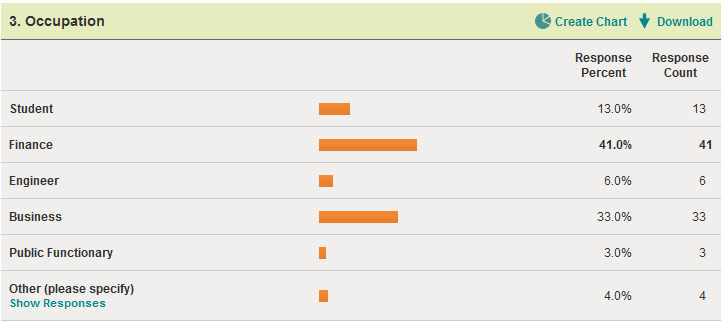
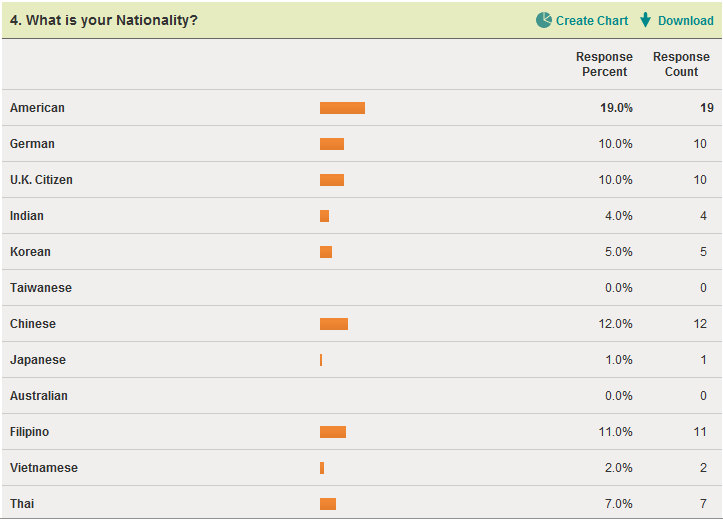

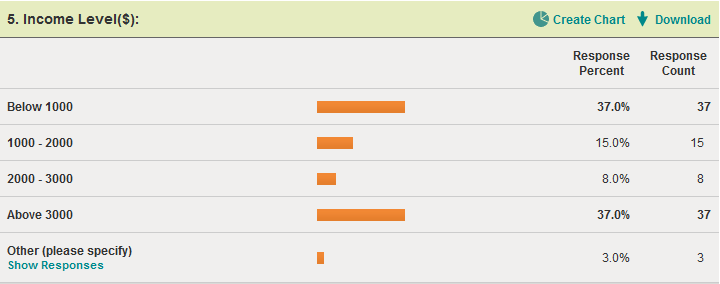
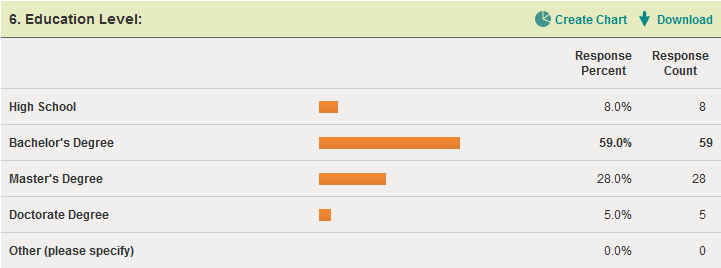
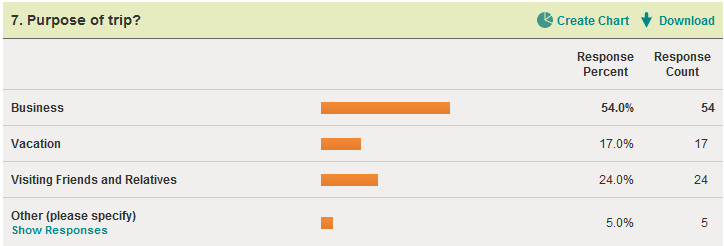
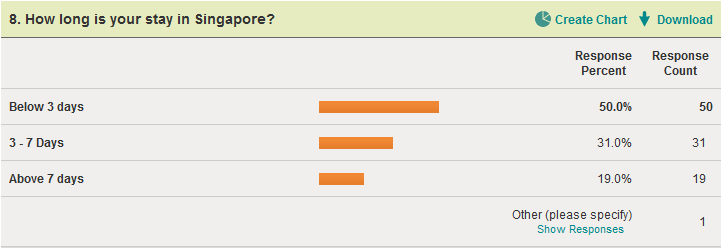
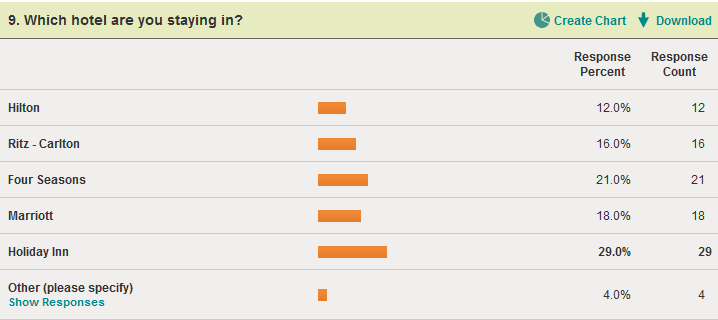
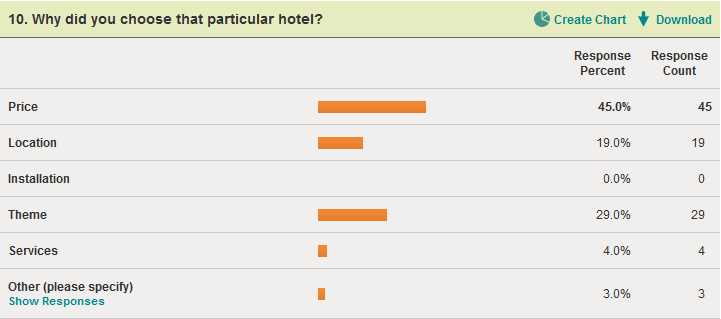
Survey Part 2.
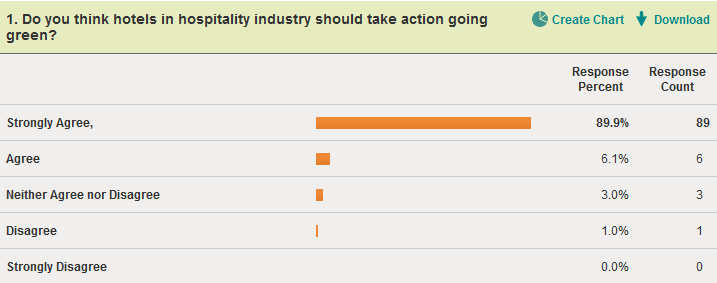
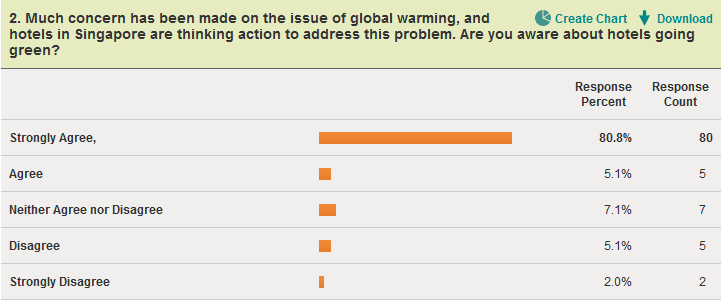
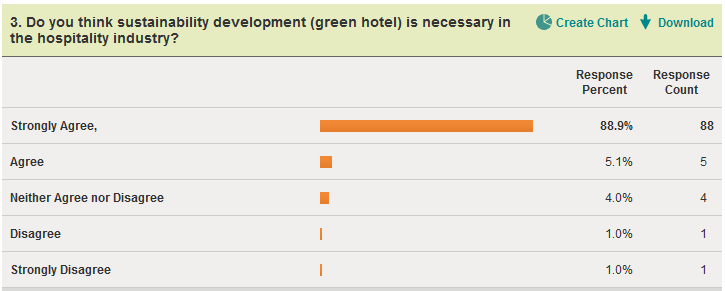
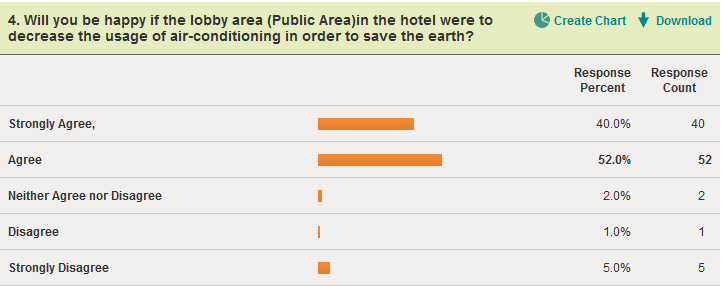
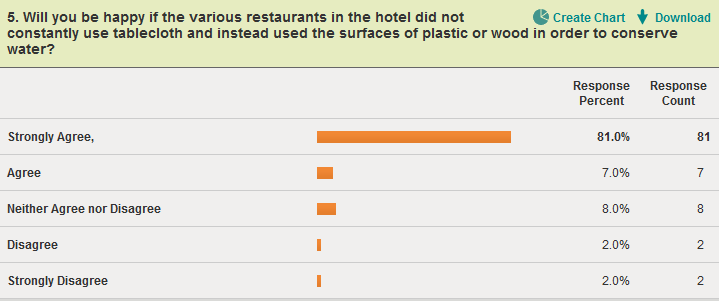
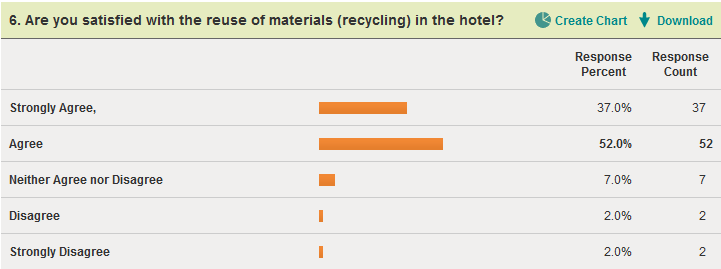
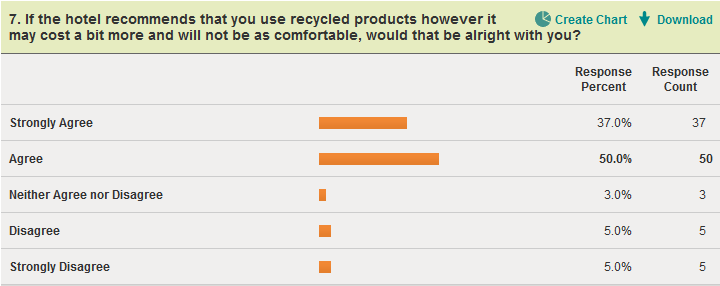
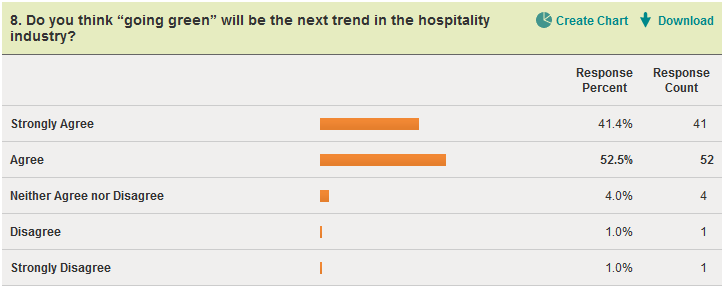
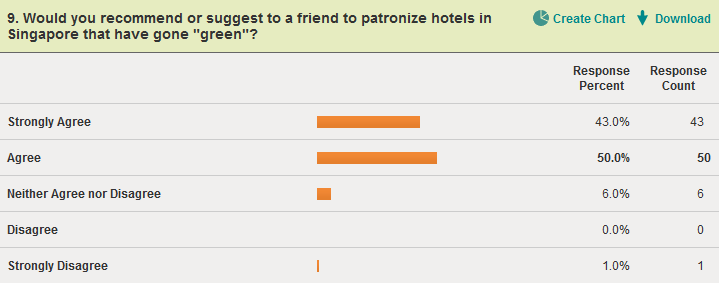
Analysis and Discussion
Theoretical Framework
Theory of Consumer Behavior
The theory of consumer behavior revolves around the concept of the perceived value or satisfaction that a consumer derives from the consumption/ use of a particular commodity. In terms of actually understanding the demand side of market consumption/utilization, the theory of consumer behavior uses two distinct methods of measurement, namely Total Utility (TU) and Marginal Utility (MU). Total utility is defined by various experts in the field of consumer behavior as being the equivalent to the total level of satisfaction that a consumer can get from the use/consumption of a particular good or service.
In the field of analyzing consumer behavior marginal utility is basically described as an add-on, namely, it is the additional form of satisfaction that a consumer /hotel guest can get from the use/consumption of an added portion of a particular good or service. It must be noted though that while total utility increases with the overall level of quality, at some point due to the continuous consumption of a particular product or use of a type of service the overall yield will result in smaller and smaller levels of additional utility towards the consumption. To illustrate this point one can imagine a person buying a scoop of dark chocolate ice cream at an ice cream store due to the hot and humid weather.
While initially the total utility and marginal utility are equal if the person were to go back and kept on buying the same product in order to stay cold the total utility would increase due to the consumption however the marginal utility would decrease over time as a result of the continuous consumption of the same product (Taylor,1974). This is based on the notion that continuous consumption of the same product would eventually cause a person to get tired of consuming it thus the added value continues to decrease over the course of consumption. In order to better understand how such a concept integrates itself into business planning and marketing the four fundamental concepts of consumer choice must be taken into consideration namely: rational behavior, preferences, budget constraints, and prices (Weaver,2006).
The concept of rational behavior assumes that all consumers are rational individuals who try to use their earned income in order to derive the greatest amount of satisfaction/ utility (Taylor,1974). In other words, consumers try to get the most out of their income through rational buying behavior which results in a maximization of total utility from the products or services used. This rational behavior is based on the fact that consumers will act in an economically competent manner in that they will not spend too much money on irrational purchases or services. This can take the form of stockpiling unneeded products or choosing certain services that are well beyond their budgetary means.
As such the concept of rational behavior assumes all consumers engage in rational buying behaviors which becomes the basis for any future analysis of consumer patronage towards a particular type of product or utility. The concept of preferences is based on the fact that each individual consumer has his/her own personal preference towards a particular service or product that is currently available in the market from which they are able to derive the greatest amount of total utility/ satisfaction. As such consumers are inherently aware of how much in the way of marginal utility they are able to derive from successive use/consumption of a particular product or service.
It must be noted though that the amount of marginal and total utility derived from a particular product or service differs based on each individual consumer group since they all have individual tastes, preferences, and ideologies. Under the concept of budget constraints, each consumer is assumed to have a fixed and finite income due to the limited amount of work in exchange for income each individual consumer is capable of achieving. In this case, it is assumed that there is unlimited demand for goods and services however this is offset by a limited income. Finally, the concept of prices assumes that each individual consumer is part of the total demand in the market.
Due to the limited amount of income each consumer is capable of achieving they must choose to obtain the best combination of goods that maximizes their total utility while at the same time remaining within a certain price range. In this study, the point of view of the consumer, namely consumer preference, plays an important role in determining whether the total utility of the consumer knowing that the hotel they are staying in practices environmentally beneficial practices actually contributes to consumer patronage of that particular hotel chain. It must be noted that while the concept of consumer preference plays an important role in the choice of a particular product or service the fact remains that the remaining concepts of rational behavior, budget constraint, and price also play roles that can actually override the concept of preference.
While a consumer may prefer to stay in a hotel that has gone green barriers to this choice in the form of higher prices which directly conflicts with a consumer’s inherent budget constraints would thus change their pattern of behavior to choose a more affordable solution in order to conform to what is rational. On the other hand, if an environmentally-conscious consumer is presented with two choices namely a hotel that has gone green while the other has not with both prices being similar it is likely that the consumer will choose the former choice rather than the latter.
This decision is influenced by all concepts of consumer behavior wherein preference and rational behavior for environmentally beneficial practices led the consumer to choose the hotel that had gone green while the similar prices for each hotel conformed to the consumer’s budget constraint thus letting the choice be left up to preference. It must be noted that the theory of consumer behavior is basically an examination of what influences a consumer’s choice in a particular product or service, should a consumer be presented with the same service with both being within budget constraints and prices the choice is usually left up to consumer preference.
On the other hand, if a choice is beyond budget constraints, price level and is considered to be an irrational choice preference is no longer included in the decision making process. Thus in terms of understanding consumer behavior preference should not be considered the sole deciding factor in understanding consumer behavior rather a combination of rational behavior, preference, budget constraints, and price must always be taken into consideration in order to understand how consumer behavior towards a particular product or service works.
Examination of Survey Participants
The results of the survey show that a majority of the participants in the survey are male and are between the ages of 25 to 45. While there were female participants during the period when the surveys were being collected from the various hotels there were more male visitors rather than female guests, this explains the apparent discrepancy with 86% of the participants being mostly male.
On another hand the percentile difference in age was rather surprising, this study expected more people below the age of 25 to be hotel guests, instead, a majority were 35 to 45 years old in age. Various interviews conducted throughout the survey collection process reveal that on average most corporations sponsor the trips of employees going to Singapore to conduct business for the company.
Due to the cost and importance associated with such international trips companies often send mid-level or senior staff members to Singapore rather than junior members of the company. This is an important factor to take note of since this reveals a particular demographic that hotels in Singapore should take into account when shifting operations towards environmentally sustainable practices. Various studies involving consumer preference and the environment indicate that that age demographic of consumers that prefer to utilize environmentally friendly products is between the age of 25 to 45 (Griskevicius et al., 2010).
This is due to a greater degree of environmental awareness and desire from conservation as compared to individuals aged 24 or younger that are more concerned with the latest pop culture trends. While there is no set age where the development of environmental awareness takes place, it is a generally accepted notion that people who regularly travel are more susceptible to various climate and environmental changes. A recent survey of various European business professionals who made regular trips from Europe to China indicated that a majority of them wished that China enacted more environmentally beneficial practices due to the level of smog and pollution that affects many of the major cities (Griskevicius et al., 2010).
They mention that they were more likely to get sick from a trip to China as compared to traveling within Europe due to the sheer amount of air pollution that they experienced while in China. Other studies into consumer preference and traveling indicate that on average most travelers prefer the proliferation of environmental stewardship since they are the ones most affected by pollutants in the atmosphere that may affect their health. Other studies involving pollution and international travel show that many individuals are reluctant to visit countries such as India due to the perceived amount of pollution and environmental malpractices they see on a daily basis. Various online travel blogs, trip advisors, and guides show that on average most travelers prefer to travel to countries that are clean and have good records in terms of environmental stewardship.
While Singapore is widely recognized as one of the cleanest countries in the world there are still various businesses that conduct practices that are far from being environmentally beneficial such as the wastefulness seen in various hotels near the central business district. With the growing proliferation of environmental awareness among air travelers and the fact that a majority of visitors, as indicated by the survey, are within the demographic of individuals who are more inclined toward environmental awareness, this sets the precedent for changing hotel operations towards a more environmentally conscious manner so as to attract this growing demographic of visitors into Singapore.
Segmentation, Targeting, and Positioning
The process of segmentation, targeting, and positioning is a three-stage process used to determine what kind of consumers exist, what type of consumer the business is best off catering to, and finally optimizing the method of operations/services of the business in order to take advantage of that chosen segment and distinguish the business from its various competitors. In the case of this study, this takes the form of identifying the various groups of hotel patrons that come to Singapore on a daily basis.
As seen from the results of the survey the highest hotel demographic are individuals aged 25 to 45, this segment is further separated into consumer groups that prefer environmentally beneficial practices, groups that do not care either way and finally, consumer groups that belief hotels switching towards green practices is actually detrimental for their overall level of comfort (Schultz,2010).
When taking the concept of consumer targeting into consideration it must be noted that a business cannot be all things to all people since only a limited number of operational procedures can be implemented at any one time. As such businesses tend to specialize in meeting the needs of specific consumer groups due to the higher rate of profitability rather than a generalized approach towards company operations.
For the case of hotels in Singapore, they can choose to target three groups from their highest yielding demographic of people aged 25 to 45 (Schultz,2010). When examining the three groups it is easily noticeable that the group that believes green practices are detrimental to their comfort is the group with the lowest possible benefit for the hotel. As it was mentioned earlier going green has long-term benefits for hotels in terms of operational cost savings and a better image of corporate social responsibility.
If a hotel were to continue serving a consumer demographic that would cost more in the long run and would not lead to any improvement in a hotel’s overall image; the choice of catering to environmentally aware consumers is quite obvious as a result of this conclusion. Based on this, the best strategy to employ would be the concentrated strategy where companies focus on catering to one particular segment in the consumer populace while allowing competitors to have the remaining segments.
By catering to a growing environmentally conscious visitor base international hotels in Singapore not only reduce their costs of operation but also contribute to sustainable development and improvement in the hospitality industry. After segmentation and targeting come the concept of product positioning in which a company/organization chooses to implement a chosen image that is meant to appeal to a certain segment of the consumer population (Romeril, 1985).
For hotels in Singapore, this means adopting environmental stewardship as an aspect of their business operations and getting the proper certifications to indicate the hotel complies with set international standards in green operations (Romeril, 1985). The consistent and recognizable image of being green is meant to capitalize on the ability of the customer to recognize a particular offering that entices them to use a certain product or service (Reynoso & Heusinger,2010). With the environmental conservation movement continuing to grow in popularity, proper positioning to take advantage of this growing consumer demographic can result in better profit margins for hotels as a result of lower operational costs and higher consumer patronage.
Connection of Income Level with Decision Making Process
The four fundamental concepts of consumer choice must be taken into consideration namely: rational behavior, preferences, budget constraints, and prices when trying to determine what drives the decision-making process of consumers to choose a particular type of hotel. In the hotel survey, four different kinds of income streams were added namely: those below $1000, $1000 – $2000, $2000 – $3000, and income streams above $3000.
These levels of income were directly contrasted to the decision-making process of the customer. The survey revealed that the greatest factor in the decision-making process for hotel guests was the price of the hotel, followed by the theme, then the location, and finally the services offered. It is the assumption of this study that as income levels increase the propensity for consumers to go beyond the demographic of price and consider other factors in the decision-making process such as theme, location, and services increases as well.
In order to prove this point, the four fundamental concepts of consumer choice will be utilized in order to trace consumer behavior in this study and will attempt to explain how hotel guests make their decisions regarding what hotel chain to patronize. The concept of rational behavior assumes that all consumers are rational individuals who try to use their earned income in order to derive the greatest amount of satisfaction/ utility. In other words, consumers try to get the most out of their income through rational buying behavior which results in a maximization of total utility from the products or services used.
For people choosing between various hotels within Singapore, this means choosing the appropriate type of hotel that is commensurate with the budget that they have. The results of the survey show that there are two particular levels of income that act as majorities in the income selection namely incomes below $1000 and incomes above $3000. An examination of the individual surveys shows that individuals with incomes below $1000 chose prices as the determining factor in choosing hotels while those with incomes above $3000 chose themes, location, and services as the primary factors behind their decisions.
Such actions conform to the concept of preferences which is based on the fact that each individual consumer has his/her own personal preference towards a particular service or product that is currently available in the market from which they are able to derive the greatest amount of total utility/ satisfaction. For consumers on vacation or on a business trip in Singapore, their preferences are set according to their inherent preferences which are greatly influenced by their income.
Consumers with greater incomes thus have a different set of preferences as compared to those who have lower income rates. What must be understood is that under the concept of budget constraints each consumer is assumed to have a fixed and finite income due to the limited amount of work in exchange for income each individual consumer is capable of achieving. Due to the limited amount of income each consumer is capable of achieving they must choose, under the concept of price, to obtain the best combination of goods that maximizes their total utility while at the same time remaining within a certain price range.
In this study, the point of view of the consumer, namely consumer preference, plays an important role in determining whether the total utility of the consumer knowing that the hotel they are staying in practices environmentally beneficial practices actually contributes to consumer patronage of that particular hotel chain. It must be noted that while the concept of consumer preference plays an important role in the choice of a particular product or service the fact remains that the remaining concepts of rational behavior, budget constraint, and price also play roles that can actually override the concept of preference.
While a consumer may prefer to stay in a hotel that has gone green barriers to this choice in the form of higher prices which directly conflicts with a consumer’s inherent budget constraints would thus change their pattern of behavior to choose a more affordable solution in order to conform to what is rational. Based on this, hotels in Singapore cannot immediately assume that if they change their method of operation to more environmentally sustainable practices that more guests will immediately patronize their hotel chain.
Studies into the pricing scheme used by various hotel chains that have gone green indicate that despite them having slightly lower operational costs as a result of proper environmental stewardship the cost of a hotel stay has remained the same in such hotels and even continues to increase over the years as the price of utilities themselves increase.
The expectation of consumers that just because a hotel has gone green means that the price of staying in a room has gone down is a faulty idea at best. Hotel prices are influenced not only by operational costs but by the cost of staff salaries, government taxes, corporate profit goals, and investor expectations. Even if a hotel were to go green in Singapore it is likely that room rates will remain the same, as such, based on the results of the survey, it is likely that adopting environmentally beneficial practices will more likely appeal to individuals with salaries of $3000 and above that take into account other preferences aside from price when choosing a hotel to stay in.
Consumer Environmental Awareness
The second and most important part of the survey that was conducted examined the opinions of guests towards going green, limiting the use of water and electricity, employing environmental cost saving measures as well as their general opinion towards environmental stewardship as a whole. The results showed an overwhelming majority regarded hotels going green as a positive trend with guests indicating that they would patronize hotels that they knew were going green.
This indicates a positive shift in the way hotel patrons perceive how wasteful the original state of the hospitality industry was and how it is necessary to create a means for the hospitality industry in Singapore to adopt methods of sustainable development in order to help contribute to environmental conservation. It must be noted that tourism on average is actually one of the leading sectors in the global economy with billions of dollars in annual spending contributing to the economies of many developing countries. In the span of a single year millions of individuals use planes and hotels in their itineraries and as a result, this creates a great deal of resource expenditure per year.
The reason this is being mentioned is that even though guests indicate that they overwhelmingly support the initiative to go green the fact remains that not all of them are actually capable of changing their preference to accommodate the preference for going green in their hotel stay. As it was mentioned earlier guests with incomes below $1000 oftentimes choose price over preference due to the need to comply with the notion of being a rational consumer. The survey results show that most guests tended to check in with hotels with a relatively low level of environmental stewardship yet cost less compared to hotels that stated they were going green but cost more.
One survey conducted in 2007 by the Association of Corporate Travel Executives revealed that while various travelers indicated that they would prefer to use a hotel that had gone green when traveling they often chose hotels with much lower prices when given the choice. The survey conducted by this study yielded similar results where guests stated they would choose green hotels and would recommend green hotels to their friends but when it actually came to their hotel of choice they went for affordability.
What this means for hotels in Singapore is that changing to green practices should not be based upon consumer perspective but rather internal attempts to advocate environmental stewardship through revamping general operational procedures. The problem with consumer opinion, as seen in the 2007 survey by ACTE and by this study, is that consumers can and often do change their preferences quickly when presented with a situation that directly conflicts with what they perceive to be a violation of the maximization of their total utilities. In order to better understand this type of concept, the theory of consumer behavior is needed in order to better understand how such types of behavior come about.
The theory of consumer behavior revolves around the concept of the perceived value or satisfaction that a consumer derives from the consumption/ use of a particular commodity. Two distinct methods of measurement are used in this theory, namely Total Utility (TU) and Marginal Utility (MU). Total utility is defined by various experts in the field of consumer behavior as being the equivalent to the total level of satisfaction that a consumer can get from the use/consumption of a particular good or service.
In the field of analyzing consumer behavior marginal utility is basically described as an add-on, namely, it is the additional form of satisfaction that a consumer /hotel guest can get from the use/consumption of an added portion of a particular good or service. These are important factors to consider especially when taking into account the nature of consumer surplus and how this affects consumer patronage towards a particular hotel chain that has gone green.
Consumer surplus is identified as the excess amount that consumers are willing to pay for a particular service or product at a given time as opposed to the actual worth of the product. When taking this idea and framing it within the context of a hotel going green it can be assumed that environmentally conscious guests that are visiting a particular hotel chain for the first time would be willing to pay more for their stay due to their preference for environmentally beneficial practices however it cannot be stated that they would be willing to choose that hotel chain again if the price of staying there is greater than that of other similar hotels with lower price ranges yet do not engage in green activities. Another way of looking at this is to see what particular types of hotels are going green and which are not.
Various interviews from hotel staff and consumers show that only a select few hotels within Singapore are going green such as Hyatt, Shangri-la, Regent Singapore, and the Fullerton hotel while others continue to use the same standards as they did before. The one difference between the hotels that have gone green with those that have not is that while prices have remained relatively unchanged the price of a hotel room in the various hotels that have not gone green is actually lower. Earlier it was mentioned that going green does not actually contribute to lower room rates but rather helps in reducing operational wastefulness.
The various hotels that had gone green already had higher room rates as compared to those that did not as such consumers seeking to spend less money chose to go for cheaper hotel rates. This does not mean that consumers do not like the concept of going green but from a guest’s perspective, the four concepts of consumer choice namely the concept of rational behavior, preference, budget constraints, and prices means that when given the choice between the rational act of choosing a cheaper hotel over that over a more expensive yet green hotel the most rational path to choose would, of course, be the much cheaper room rate.
What must be done in order to “Go Green”?
Changing Hotel Business Culture
In order for a hotel to “Go Green” so to speak a sustainable business culture is needed in order to properly facilitate the needed actions. The business culture of any corporation directly influences the manner in which a company operates.
Unfortunately for the hotel industry, the business culture developed is one that facilitates wastefulness on account of the supposed need to please guests. In order to resolve this issue the first step that must be done is to evaluate the current “greening” status of the company by examining the performance indicators of the company such as energy and water use, the energy capacity of current hotel equipment, the efficiency of various hotel devices, waste disposal practices, the use of hazardous chemicals during regular maintenance and awareness of hotel employees of the environmental stewardship.
The reasoning behind the collection of such information lies in the fact that by examining the current state of the hotel’s expenditure on resources and the knowledge the staff has towards going green the hotel will be able to measure up to what extent is the current “green deficiency” of the hotel itself. On average luxury hotels in Singapore have an energy cost of 427 Kilowatt-hours for every square meter of floor space not only that individual hotel’s consumer well over 66,000 thousand gallons of water per year due to operations associated with cleaning and daily hotel maintenance (Priyadarsini et al., 2009).
Compared to the current European standard of fewer than 300-kilowatt hours per square meter Singaporean hotels actually consume more than 40% percent more electricity than their European counterparts
(Priyadarsini et al., 2009). Studies done by Dr. Lee Siew Eang who is the head of the sustainability unit of the NUS indicates that upon interviewing various hotel managers and staff regarding energy efficiency in hotels a majority of them stated that energy efficiency was not at all related to their method of operation and that it was their supposed “duty” to be extravagant (OOI,2003). This type of business culture reflects poorly on the ability of the Singaporean hotel industry to comply with environmental stewardship and must be changed in order to reduce wasteful resource use.
House Keeping and Maintenance
The housekeeping and maintenance departments of most hotels are actually among the greatest contributors to environmental waste in the hotel. For a lot of individuals that have stayed in hotels in the past regular housekeeping services to change sheets, pillowcases and shampoos were regularly thought of as inconsequential and a daily part of hotel living. The one problem with what housekeeping does is that they do it too often than what is necessary.
Sheets and pillows are changed on an almost daily basis which contributes to the laundry loads in the hotel which inevitably uses more water than is necessary. Replacing various soaps, shampoos, and conditioners in hotel bathrooms before they are even finished results in additional wasteful practices that contribute to hotel operation expenses. While it is understandable that various hotels are trying to uphold a certain standard of luxury the fact remains that what they are doing actually contributes to the environmentally wasteful practices associated with hotels. Not only that the various industrial strength detergents used by the hotel are quite toxic in the natural environment.
With thousands of gallons of chemical cleansers used on a yearly basis, this adds up to the additional environmental damage that hotels are responsible for (Middletion and Hawkins, 1998). By establishing new programs that reduce the amount of cleaning to a more environmentally beneficial manner as well as using non-toxic biodegradable cleaners hotel housekeeping and maintenance staff will be able to help reduce operating costs as well as contribute to environmental stewardship.
Is the law of diminishing marginal utility applicable to consumer behavior for hotels going green?
An examination of the law of diminishing marginal utility by this study shows that when a particular type of consumer that has been placed under a particular demographic get/consumes several units/portions of a particular product or service (this can come in the form of either hotel stays, massage services or something simple such as eating chocolate) the additional utility (marginal utility) (namely the added pleasure/ feeling of consumption) that a consumer can get from getting more of a particular product/service diminishes after each level of consumption.
Since the hospitality industry is a type of service consumers employ when they travel it is ordinarily not subject to the law since the service being consumed is not consumed on a successive basis as such the additional utility does not decline at the same rate (Njite et al., 2008).
On the other hand, if the consumer in question does successive trips or the entirety of a consumer’s travel history is taken into consideration then the law can be applied however in most cases such exemptions are not taken into consideration (Njite et al., 2008). As such an examination of the benefits of a hotel going green from a guest’s perspective would thus have to focus on the total utility gained from the stay rather than the decline in marginal utility since an examination of the marginal utility cannot be done due to the infrequent use of such a service.
This is an important factor to consider especially when taking into account the nature of consumer surplus and how this affects consumer patronage towards a particular hotel chain that has gone green. Consumer surplus is identified as the excess amount that consumers are willing to pay for a particular service or product at a given time as opposed to the actual worth of the product. For example during a particularly hot summer consumers are willing to pay more for cold ice cream and soft drinks as opposed to their consumption during a particularly cold winter (Maroukian,2008).
Based on the concept of marginal utility wherein the added utility for a particular product decreases over a set period of constant consumption it can be assumed that an individual would be willing to pay more during the period the first consumption of a particular product or service as opposed to the second time it is consumed (Narayan, 2006). For example, during a very hot summer, day consumers would be willing to purchase and pay more for one scoop of ice cream or one can of soda to quench their thirst as opposed to the third or fourth scoop or can due to their thirst already being quenched (Narayan, 2006).
It must be noted that the concept of consumer surplus can actually only exist within the context of diminishing marginal utility since the successive diminishing utility from each successive consumption explains why consumers are not willing to pay more than what a product is worth after a product is first consumed (Mowforth and Munt, 1998).
When taking this idea and framing it within the context of a hotel going green it can be assumed that environmentally conscious guests that are visiting a particular hotel chain for the first time would be willing to pay more for their stay due to their preference for environmentally beneficial practices however it cannot be stated that they would be willing to choose that hotel chain again if the price of staying there is greater than that of other similar hotels with lower price ranges yet do not engage in green activities.
Conclusion
Based on the results of the survey and the concepts of rational behavior, preference, budget constraints, and prices it can be said that consumer preferences are not always accurate with what they state they want and what they actually want. Various studies have shown that due to the growing trend in environmental conservation many consumers would be willing to spend money on products that indicate that they were created through environmentally beneficial practices rather than products that do not have such a distinction. Unfortunately, when such a time comes they usually pick hotels that are cheaper instead of those that practice environmentally.
This is due to the fact that when an individual’s, when it comes right down to it, would prefer to maximize their utility with a lower priced commodity as compared to others who do not care in the least in terms of price. In order to establish a better means of sustainable development for hotels in Singapore, it would be advisable for hotel management not to listen to what various guests are saying but rather determine the next course of action depending on what would most benefit more people at the time.
References
Beil, M 2009, ‘Going ‘green’ in long-term care’, Long-Term Living: For the Continuing Care Professional, 58, 1, pp. 30-33, EBSCOhost.
Bos, J 2010, ‘GOING GREEN AND SAVING GREEN’, LabTalk, 38, 15F, p. 26, EBSCOhost.
Briassoulis, H. and Straaten, J.V.D. (2000) Tourism and the Environment: Regional, Economic, Cultural and Policy Issues. The Netherlands, Kluwer Academic.
Cater, E. and Lowman, G (1994) Ecotourism: A Sustainable Option? John Wiley & Sons: UK.
Cummings, R 2009, ‘Going Green Can Be Financially and Socially Responsible’, Journal of State Taxation, 27, 4, pp. 7-60, EBSCOhost.
Deal III, WF 2010, ‘Going Green with Electric Vehicles’, Technology & Engineering Teacher, 70, 3, pp. 5-11, EBSCOhost.
Gram-Hanssen, K 2010, ‘Standby Consumption in Households Analyzed With a Practice Theory Approach’, Journal of Industrial Ecology, 14, 1, pp. 150-165, Academic Search Premier, EBSCOhost.
Green, P, & Devita, M 1975, ‘An Interaction Model of Consumer Utility’, Journal of Consumer Research, 2, 2, pp. 146-153, Business Source Premier, EBSCOhost.
Griskevicius, Vladas, Joshua M. Tybur, and Bram Van den Bergh. “Going Green to Be Seen: Status, Reputation, and Conspicuous Conservation.” Journal of Personality & Social Psychology 98, no. 3 (2010): 392-404. EBSCOhost.
Harris, R. Griffin, T and Williams, P. (2002) Sustainable Tourism: A Global Perspective. Elsevier pp. 254-6.
Hall, C.M. and Lew, A.A (1998) Sustainable Tourism: A Geographical Perspective. Lingman, UK.
Herremans, I.M. (2006) Cases in Sustainable Tourism: An Experiential Approach to Making Decisions. Haworth Hospitality Press, NY.
Henderson, JC 2004, ‘Paradigm shifts: National tourism organisations and education and healthcare tourism. The case of Singapore’, Tourism & Hospitality Research, 5, 2, pp. 170-180, EBSCOhost.
Honey, M. (1999) Ecotourism and Sustainable Development: Who Owns Paradise? ISLAND PRESS, Washington, DC.
Judkis, M 2010, ’10 Ways to Save by Going Green’, U.S. News & World Report, 147, 3, pp. 34-35, EBSCOhost.
KENNEDY, M 2010, ‘Overcoming Obstacles to Going Green’, American School & University, 82, 6, p. 14, EBSCOhost.
Kind, J 2010, ‘Going Green by Saving Blue’, Buildings, 104, 4, pp. 46-49, EBSCOhost.
Middletion, V.T.C. and Hawkins, R. (1998) Sustainable Tourism: A Marketing Maroukian, F 2008, ‘Going, Going, GREEN’, Town & Country, 161, 5335, p. 177, EBSCOhost.
Mowforth, M. and Munt, I. (1998) Tourism and Sustainability: development, globalization and new tourism in the Third World. Routledge, NY. Perspective. Butterworth-Heinemann: UK.
Narayan, S 2006, ‘OFF WORK: SINGAPORE’, Forbes, 178, p. 66, EBSCOhost.
Njite, D, Woo Gon, K, & Lisa Hyunjung, K 2008, ‘Theorizing Consumer Switching Behavior: A General Systems Theory Approach’, Journal of Quality Assurance in Hospitality & Tourism, 9, 3, pp. 185-218,EBSCOhost.
OOI, C 2003, ‘IDENTITIES, MUSEUMS, AND TOURISM IN SINGAPORE: THINK REGIONALLY, ACT LOCALLY’, Indonesia & the Malay World, 31, 89, p. 80, EBSCOhost.
Priyadarsini, R, Xuchao, W, & Eang, L 2009, ‘A study on energy performance of hotel buildings in Singapore’, Energy & Buildings, 41, 12, pp. 1319-1324, EBSCOhost.
Reynoso, R, & Heusinger, S 2010, ‘States Offer Rich Incentives for Going Green: Is Your Company Leaving Money on the Table with Unrealized Credits and Incentives?’, Journal of State Taxation, 28, 6, pp. 29-32, Business Source Premier, EBSCOhost.
Romeril, M., 1985, Tourism and the environment –towards a symbiotic relationship, International Journal of Environmental Studies, 25, 215-218.
Schultz, M 2010, ‘The New SINGAPORE’, Travel Agent, 336, 12, p. 20, EBSCOhost.
Taylor, JW 1974, ‘The Role of Risk in Consumer Behavior’, Journal of Marketing, 38, 2, pp. 54-60, EBSCOhost.
Weaver, D. 2006, Sustainable Tourism: Theory and Practice. Elsevier Ltd, UK.
Yeoman, I. (2008) Tomorrow’s Tourist: Scenarios & Trends. Elsevier, UK. pp. 307-308.